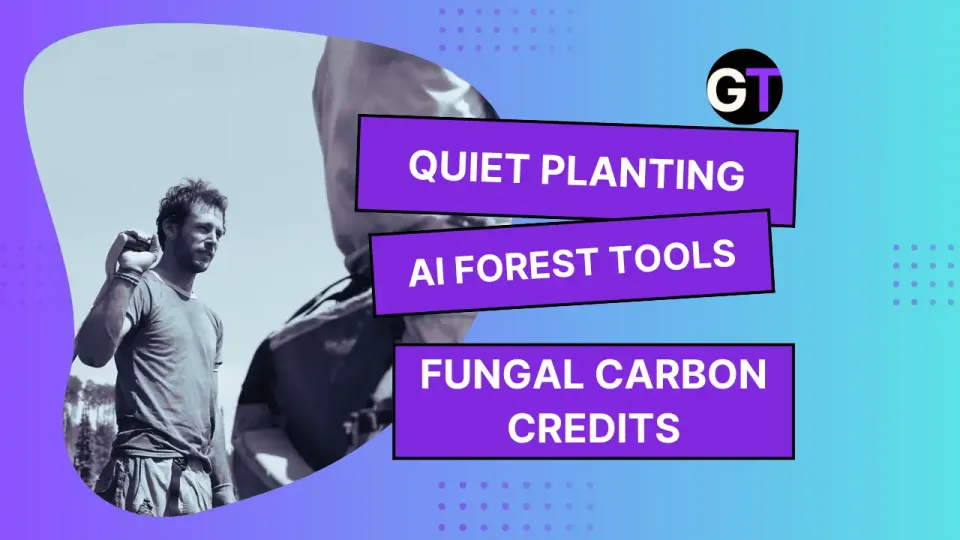Weekly News Roundup October 17 📰🌍
Greenwashing is on the decline. African carbon markets are on the rise. Read on to learn more...

Assessing Innovations for Upscaling Forest Landscape Restoration 🌱📈
A review led by Thomas Crowther dives into seven innovative techniques for scaling up global forest restoration 🌍🌱. It examines 143 studies that show how approaches like biochar, mixed plantings, and soil microbiome can help forests recover faster compared to traditional methods. The findings highlight these strategies' potential to cut costs and improve outcomes but also call for more large-scale testing.
👉👉Read more in OneEarth
Closing the Gap: Accelerating Environmental Open Source 🌿✨
Tobias Augspurger shares his exciting journey from working in robotics to diving into the world of climate tech 🌍. In 2018, he founded Open Sustainable Technology, an open-source project aimed at tackling environmental challenges. Over the past four years, this initiative has highlighted the power of open-source software (OSS) in fighting climate change, making a huge impact even with limited resources. 🚀💻
Despite funding challenges and many OSS projects going inactive, Tobias is still pushing forward 💪. He believes transparency and collaboration are key to driving sustainable solutions, and the Open Sustainable Technology project continues to inspire innovators around the world 🌱.
👉👉Read more about environmental open source on Opensource.net
How to Measure Outcomes in Forest Restoration? A European Review of Success and Failure Indicators 🌳📊
Restoration is a critical process for helping ecosystems recover from damage, especially in the face of climate change and increasing environmental stressors. 🌱🌍 Restoration can take many forms, such as ecological, forestry, or hydrological restoration. However, there’s no universal agreement on how to measure the success of these initiatives. A recent study analyzed 95 restoration projects in Europe, identifying five common indicators (like species abundanceand Ellenberg indicators) to assess outcomes. Still, there’s a need to standardize these metrics for more consistent and effective evaluations of restoration efforts. 🌳📊
👉👉Read more in Frontiers
First Greenhouse Gas Plumes Detected With NASA-Designed Instrument 🌍🚀
NASA's Tanager-1 satellite just made a big breakthrough by detecting greenhouse gas plumes from space! 🌍🚀 The satellite, launched by Carbon Mapper, spotted methane leaks in Karachi, Pakistan, and Midland, Texas, as well as a carbon dioxide plume in South Africa. Using tech developed by NASA's Jet Propulsion Lab, Tanager-1 helps scientists track down the exact sources of these harmful emissions. 🌫️📡 This is a huge step toward reducing global greenhouse gases by making emission data more accessible and actionable for everyone. 🌱💡
👉👉Read more on Jet Propulsion Laboratory
Scaling Down to Scale Up: Unlocking Carbon Markets for Small Landowners 🌳💡
Small landowners are key to forest preservation but are often excluded from carbon markets, which traditionally focus on large-scale projects. 🌲🌍 Despite owning over 50% of U.S. forestland, these small landowners face significant barriers, such as high costs and complex processes. Large projects, while well-funded, can be inefficient and prone to governance issues like corruption, leaving many landowners without a fair share of the benefits. By contrast, small-scale projects can directly benefit local communities and foster more sustainable practices.
Solutions like VM0045 and remote sensing technology offer hope, as they help simplify carbon verification and open markets for smaller participants. The key takeaway is that adapting carbon markets to include small landowners could enhance both environmental protection and economic equity. 🤝
👉👉Read more from Renoster
Carbon Markets: How Africa Can Take Ownership of the Green Transition 🌍💪
Africa is becoming a key player in the carbon-credit market as global companies seek to offset their emissions. 🌍 However, for this system to benefit Africa as much as it does multinationals, greater transparency and fairness are crucial. The Congo Basin, one of the world's largest carbon sinks, has attracted significant attention. Funds from carbon markets could support local communities by combating deforestation and promoting development. 🌳💡 Still, challenges remain, including ensuring that carbon-offset projects provide real emission reductions and that local communities receive fair benefits. 🌱
👉👉Read more on the Africa Report
Greenwashing Cases Fall for First Time in 6 Years, But High-Severity Filings Surge: Report 📉⚠️
The number of global greenwashing cases dropped by 12% between June 2023 and June 2024, marking the first decline in six years. 🌍📉 However, while overall cases fell, the severity of greenwashing incidents rose by 30%, according to RepRisk’s latest report. The U.S. saw a slight increase in cases, while the EU experienced a significant drop. 💼 Despite the decline in cases, the rise in high-severity incident and repeat offenders indicates greenwashing remains a significant issue for many companies. 🌱
👉👉Read more in ESG Dive
Democratizing Technology for Global Forest Restoration 🌳💻
Sagar Aryal, Chief Technology Officer at Plant-for-the-Planet, highlights the organization's efforts to bridge the tech gap for forest restoration projects. Their Forest Cloud platform is a powerful, open-source tool designed to help small organizations monitor, track, and showcase forest recovery 🌳🌍. By offering features like TreeMapper for gathering field data, satellite imagery, and tools like FireAlert and Tracer, the platform empowers communities to demonstrate impact and ensure compliance with environmental standards.
The initiative also provides commission-free donations for restoration projects, enabling more inclusive participation in global climate action. Aryal emphasizes the importance of technology in mobilizing communities, ensuring transparency, and scaling restoration efforts to address the climate crisis.
👉👉Read more in Foundations-20.org
The Risky Business of Predicting Where Climate Disaster Will Hit 🌪️📊
Climate risk models are getting more advanced, helping businesses and governments prepare for things like floods and fires. But there's a catch: many models are "black boxes," meaning they aren't transparent about how they work, which could lead to inaccurate decisions. 🌍📊 This lack of clarity might hurt vulnerable communities, making it even more important to demand transparency in climate predictions!
👉👉Read more in Bloomberg
Climate-Ready Plans and Processes 🏙️🌱
This funding opportunity offers up to $140,000 for Canadian municipalities and eligible partners to develop climate adaptation plans, conduct risk assessments, and enhance community resilience. 🌍🏙️ The deadline to apply is November 29, 2024, and there's a focus on projects promoting equity and inclusion. Incentives are available for small, Indigenous, or collaborative projects, potentially covering up to 100% of project costs. 📅💡 Applicants are encouraged to submit early for feedback, and only one project award is allowed per lead applicant. Make sure to check out all the eligibility requirements for more details! 📄✨
👉👉Read more on greenmunicipalfund.ca
Insurers Embrace Climate Change Investments as Catastrophe Costs Mount 💼🌍
Insurance companies are increasingly investing in low-carbon solutions to tackle rising climate risks as natural disasters cause over $100 billion in losses annually. 🌍💰 According to a survey by BlackRock, 99% of insurers now have at least one low-carbon goal, with many aiming for net-zero emissions. Despite some political pushback, many insurers are embracing these investments to manage the growing risks from climate-related catastrophes, like hurricanes and wildfires. 🌪️🔥 As a result, the industry is shifting its focus from just liability protection to becoming key players in financing the global climate transition.
👉👉Read more in the Financial Times




